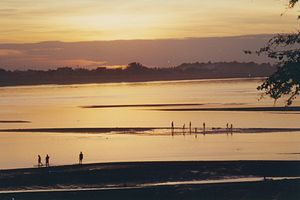Laos is pushing ahead with its plans for a third dam on the mainstream of the Mekong River in a move that will upset downstream countries, where food security remains a priority, as well as scientists and environmentalists who were hoping for a policy shift from a new leader.
The Mekong River Commission (MRC) has been told by officials in Vientiane that they will formerly enter the process of consultation regarding the Pak Beng dam to be built in the country’s northern province of Oudomxay.
Pak Beng will feed a 912-megawatt power-plant, forming a key plank in Laos’ bid to take advantage of its mountainous terrain and enrich itself by becoming the “battery of Asia” through construction of a series of dams along the Mekong River.
Construction was expected to begin next July and follows mounting international opposition already levelled against the Xayaburi and Don Sahong dams. Of particular concern are the 60 to 70 million people who rely on the river for their livelihoods.
Estimates published by Catch and Culture – a scientific journal that documents the river’s many species – valued the river’s annual fish catch of 4.4 million tons at about $17 billion. Meanwhile highly endangered species like the Irrawaddy dolphin are also at risk.
The decision to proceed also comes after the MRC – one institution charged with management of the river – was gutted financially by international donors who were upset by Laos’ pursuit of its energy strategy at any costs. A restructuring of the MRC followed, with Vietnam now exerting more influence at the expense of the authorities in Laos.
Critics have also argued the government’s spending plans are far too expensive for what this country can afford. A railroad to traverse the country is expected to cost $7 billion. The highly controversial Xayaburi dam — the first to dam the mainstream of the Mekong River — will cost at least $3.5 billion. Vientiane plans to build at least 11 dams in all and other big ticket infrastructure projects including roads, airports, tunnels, and other railways are also underway.
According to the World Bank, Laos’ GDP in 2015 was just $12.3 billion.
Further concerns mounted when the Mekong River struck historically low levels amid drought and complaints that Laos and Chinese dams upstream had interrupted normal flow. This included anger over Thailand’s decision to divert the course of the river to water a rural dustbowl on its territory.
The proposed Pak Beng dam is situated amid lush tropical jungles and mountains where locals rely on for riverbank farming, fishing, and raising livestock. Thai energy giant Electricity Generating Holding Public Co. Ltd. is believed to be involved with a Chinese joint venture partner and is expected to import much of the electricity generated by the plant.
According to International Rivers, about 25 villages in Laos and two villages in Thailand will be directly affected by construction of the dam, with an estimated 6,700 people to be re-settled.
“The rapid pace of dam development on the Lower Mekong mainstream – including the construction of the Xayaburi and Don Sahong Dams – has ignored calls from Mekong governments, donors, scientists, and concerned communities, for further studies, transboundary impact assessments and participatory regional decision-making,” it said.
It also says there is an urgent need for regional governments to press the pause button on further dams on the Mekong mainstream, to take stock of projects already under construction, and to conduct further studies on the transboundary and cumulative impacts of these projects.
The decision to proceed with Pak Beng also indicates that the secretive, communist government of recently installed president, Bounnhang Vorachith, intends to carry on with the policies initiated by his predecessor, who had earned a ruthless reputation in business.
Luke Hunt can be followed on Twitter @lukeanthonyhunt

































